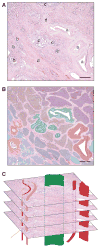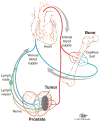Revisiting Seed and Soil: Examining the Primary Tumor and Cancer Cell Foraging in Metastasis
- PMID: 28209759
- PMCID: PMC5380470
- DOI: 10.1158/1541-7786.MCR-16-0436
Revisiting Seed and Soil: Examining the Primary Tumor and Cancer Cell Foraging in Metastasis
Abstract
Metastasis is the consequence of a cancer cell that disperses from the primary tumor, travels throughout the body, and invades and colonizes a distant site. On the basis of Paget's 1889 hypothesis, the majority of modern metastasis research focuses on the properties of the metastatic "seed and soil," but the implications of the primary tumor "soil" have been largely neglected. The rare lethal metastatic "seed" arises as a result of the selective pressures in the primary tumor. Optimal foraging theory describes how cancer cells adopt a mobile foraging strategy to balance predation risk and resource reward. Further selection in the dispersal corridors leading out of the primary tumor enhances the adaptive profile of the potentially metastatic cell. This review focuses on the selective pressures of the primary tumor "soil" that generate lethal metastatic "seeds" which is essential to understanding this critical component of prostate cancer metastasis.Implication: Elucidating the selective pressures of the primary tumor "soil" that generate lethal metastatic "seeds" is essential to understand how and why metastasis occurs in prostate cancer. Mol Cancer Res; 15(4); 361-70. ©2017 AACR.
©2017 American Association for Cancer Research.
Conflict of interest statement
The authors declare no potential conflicts of interest.
Figures





References
Publication types
MeSH terms
Grants and funding
LinkOut - more resources
Full Text Sources
Other Literature Sources

